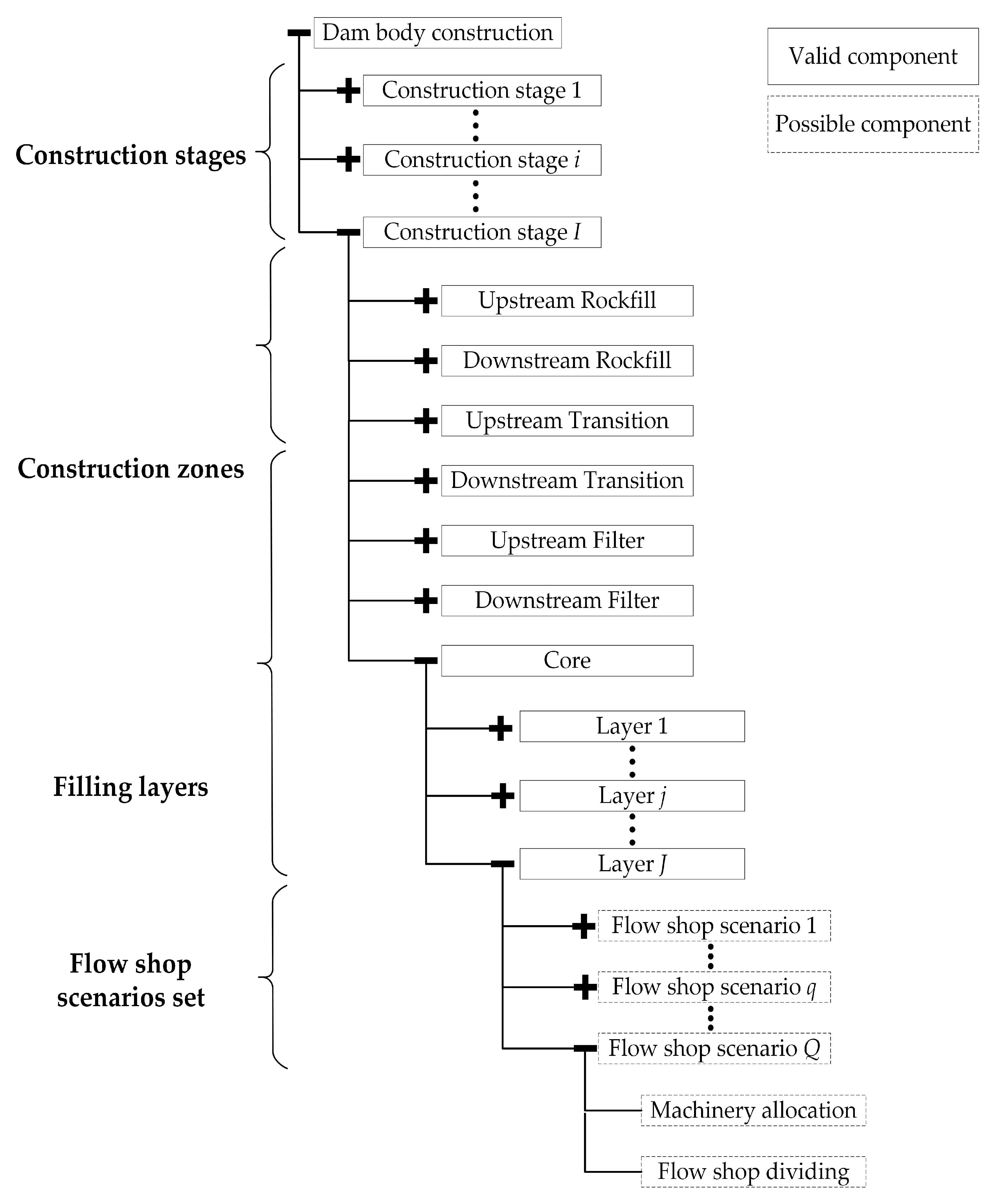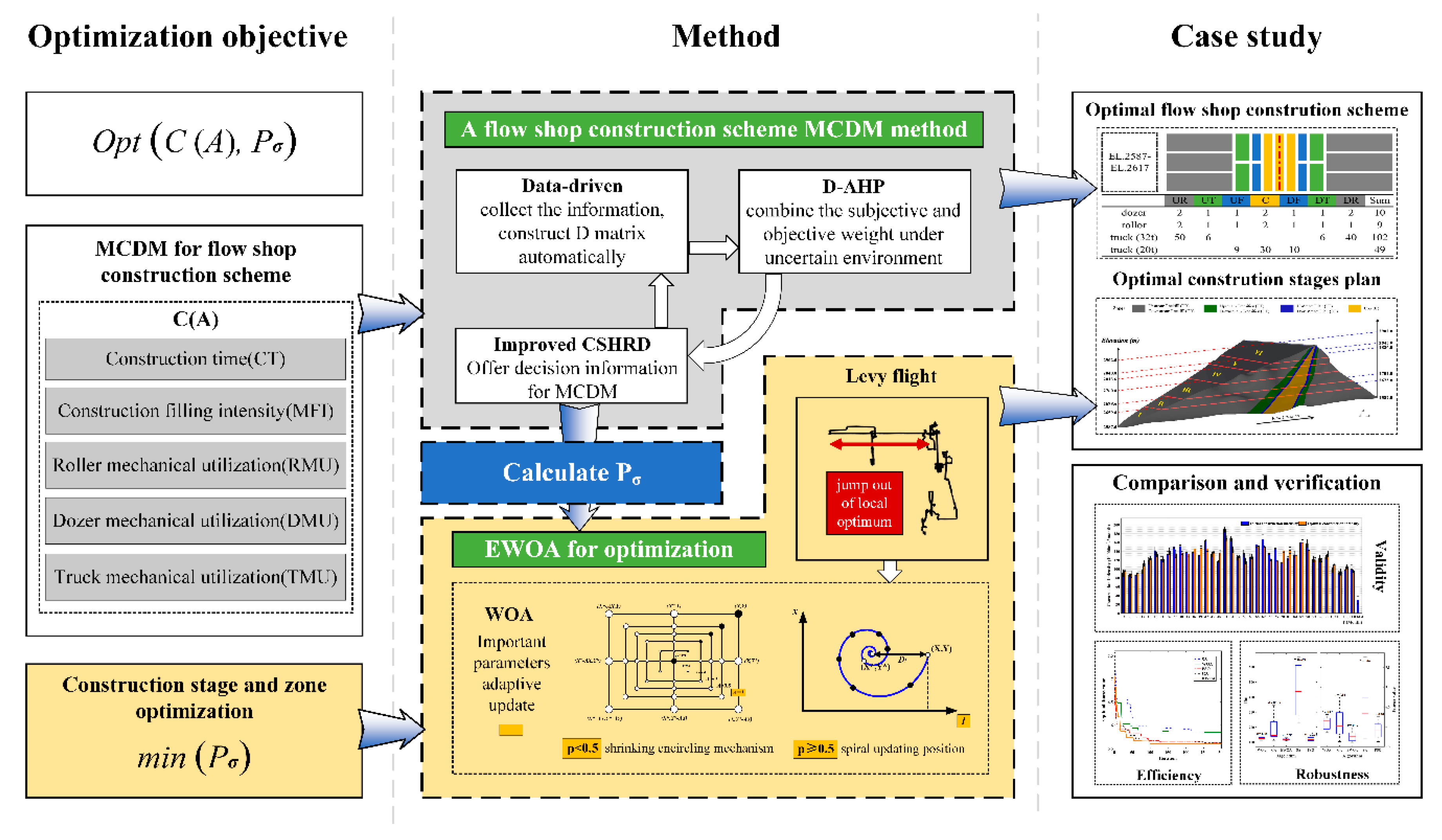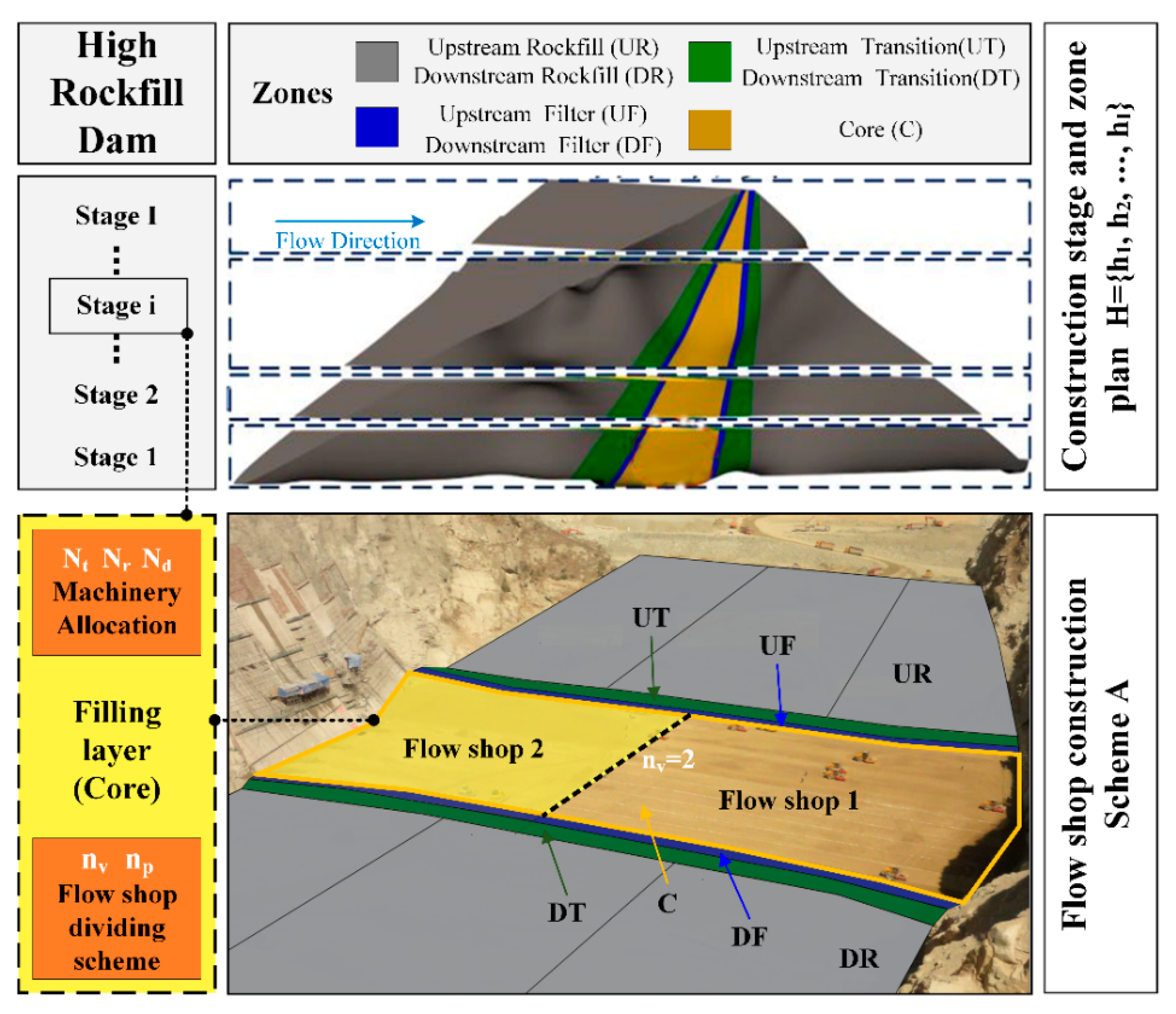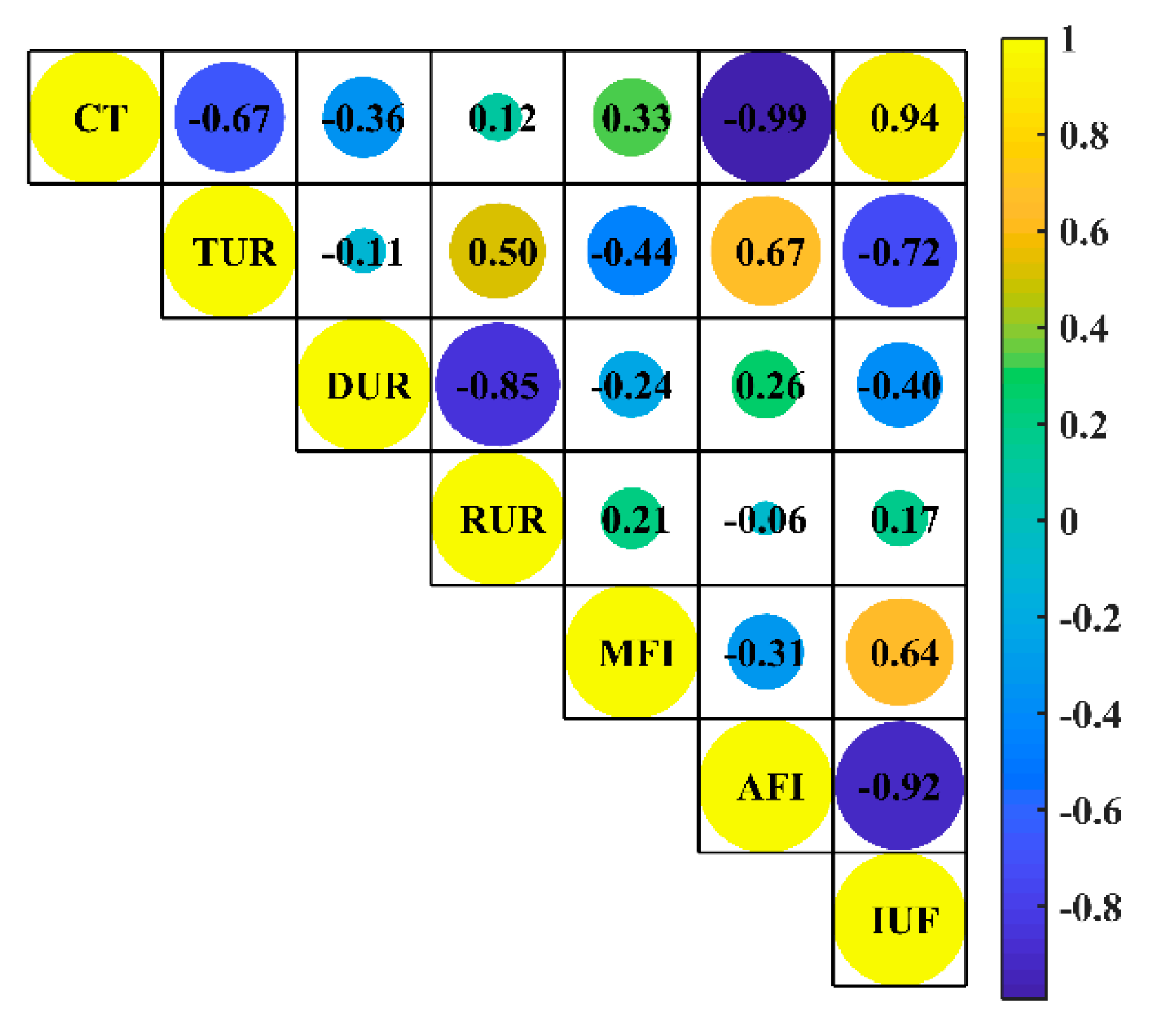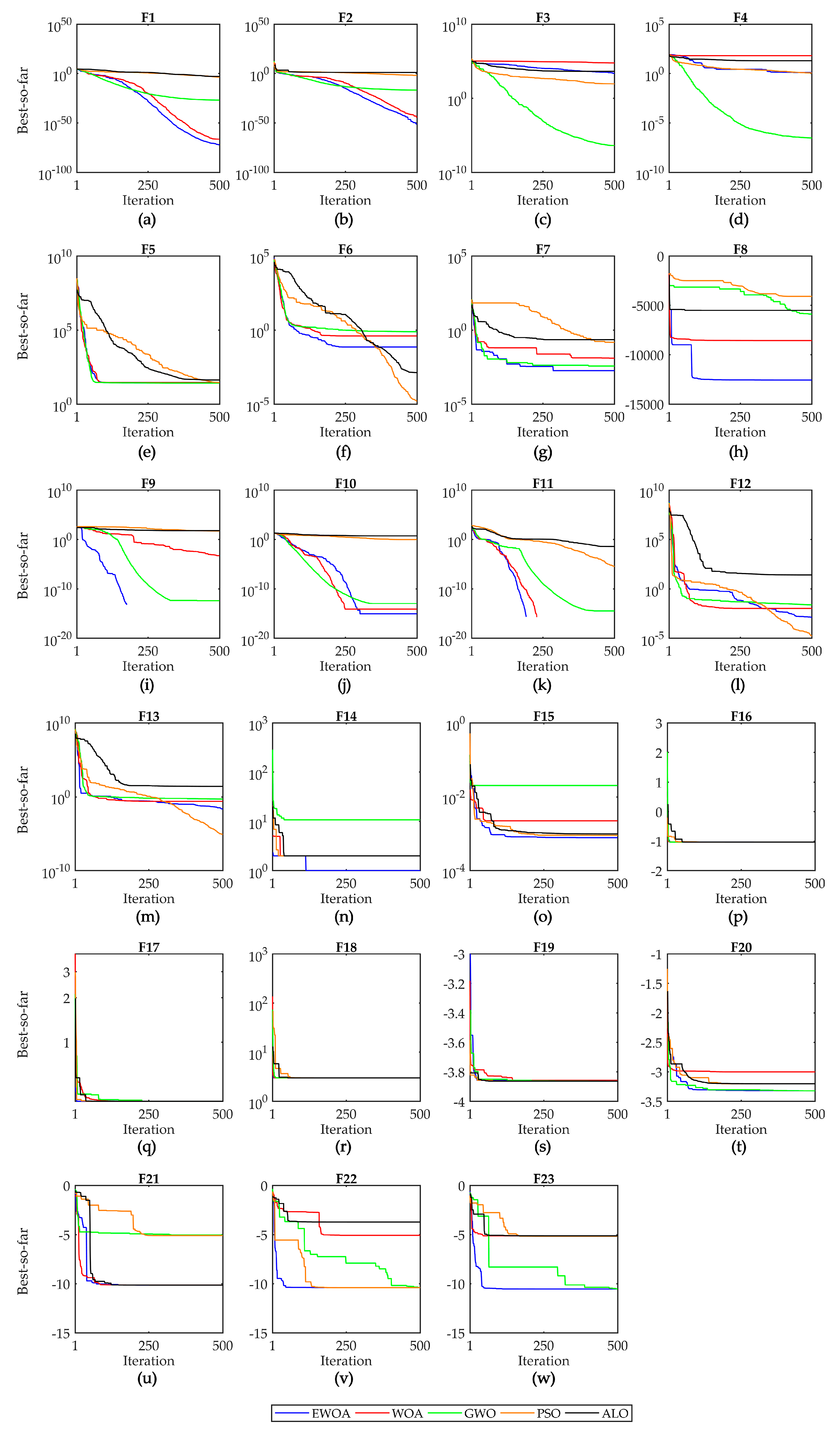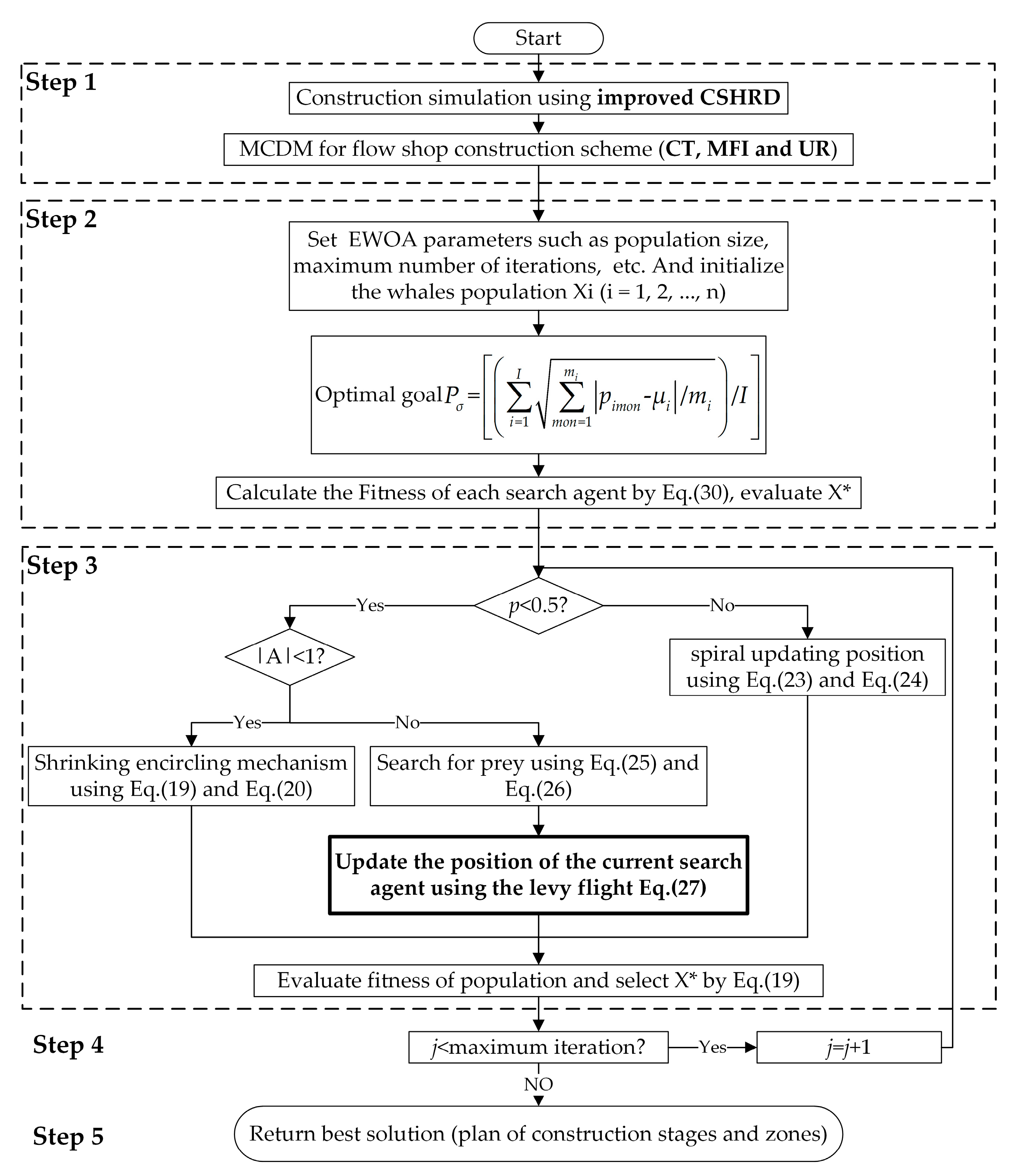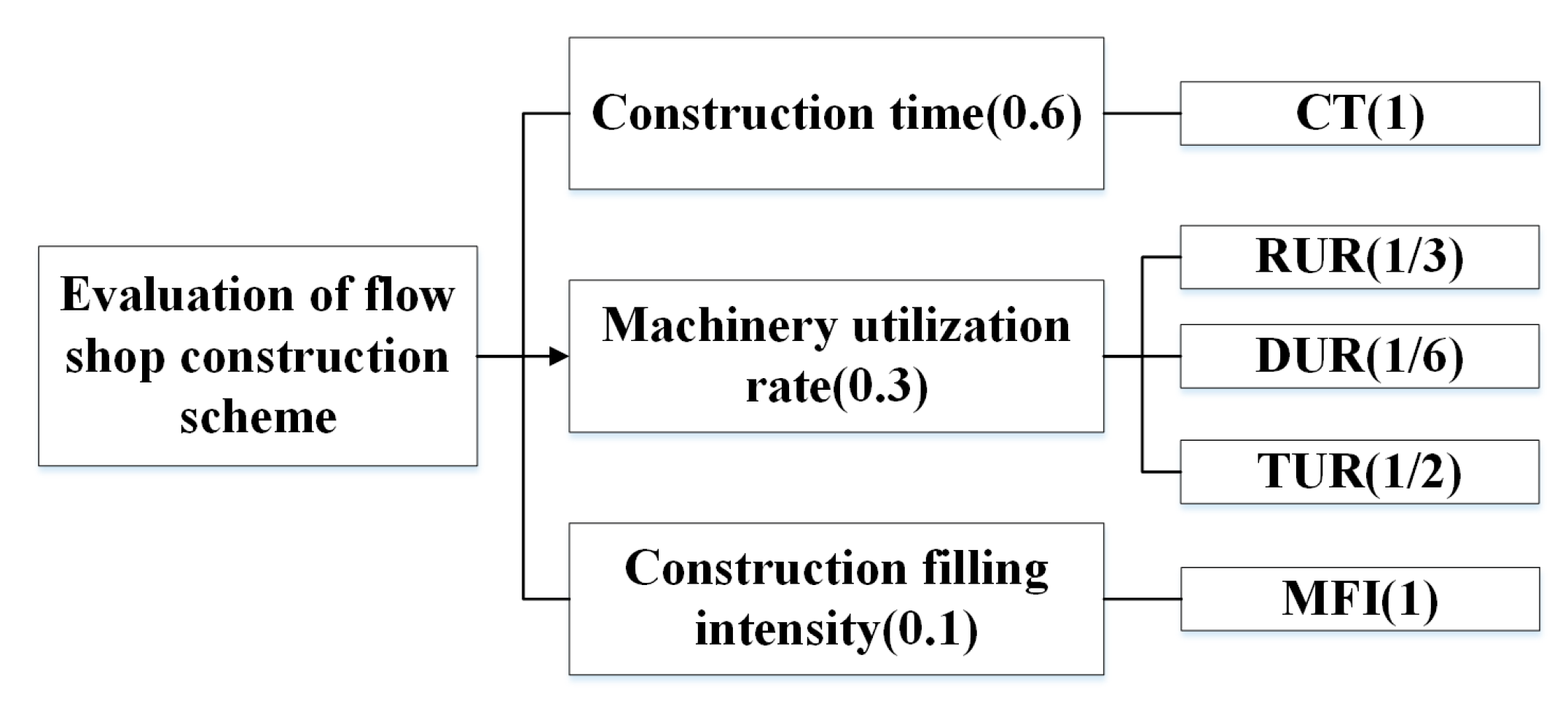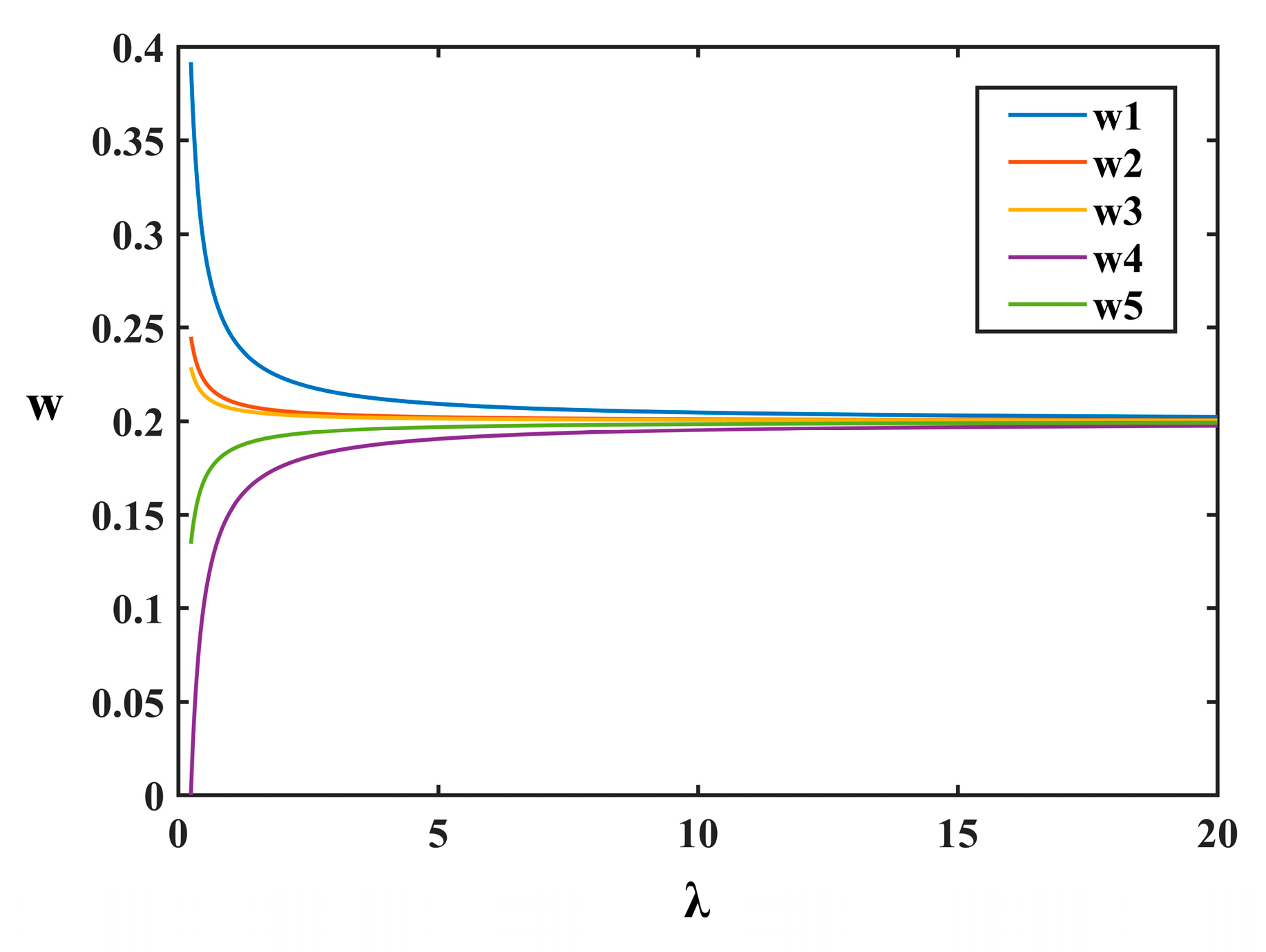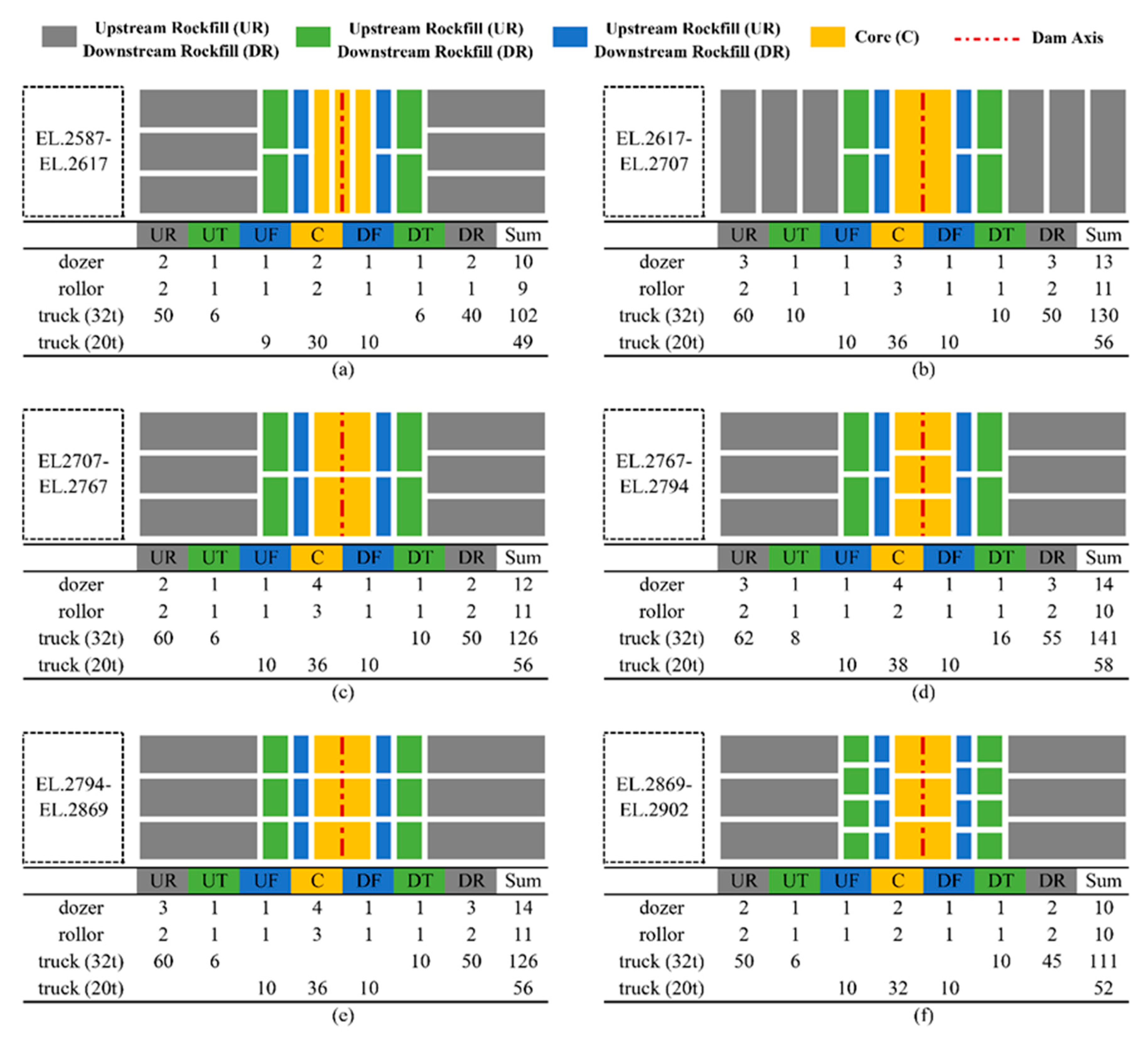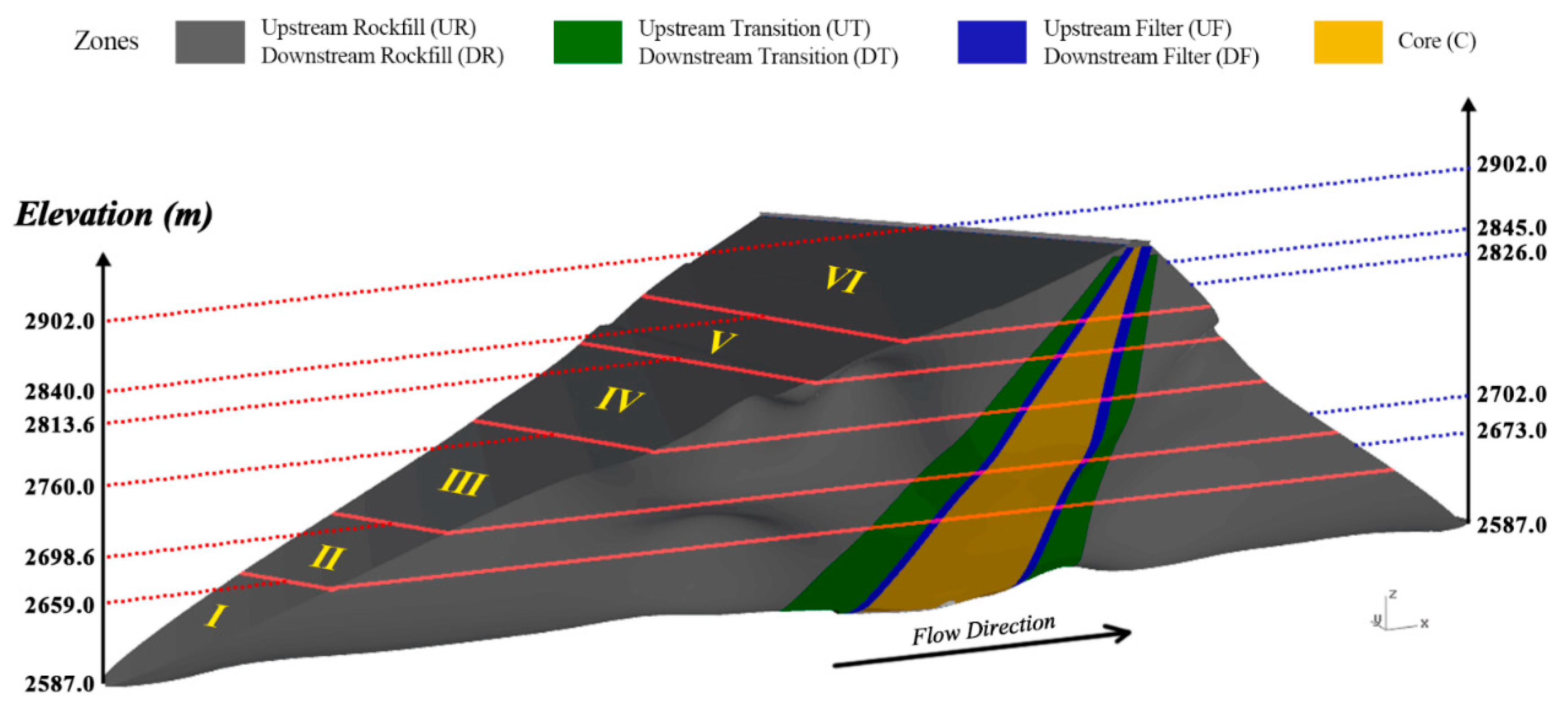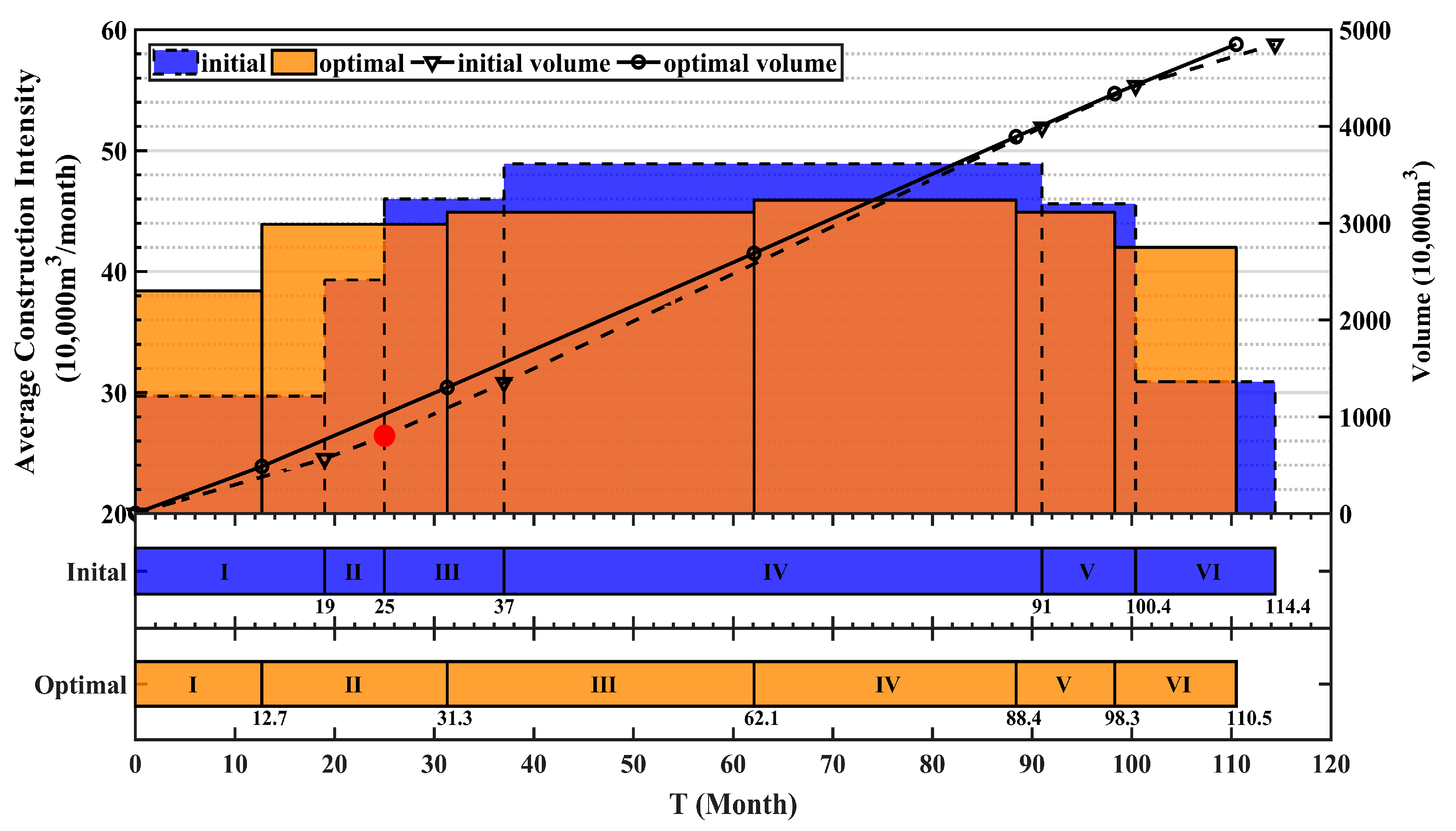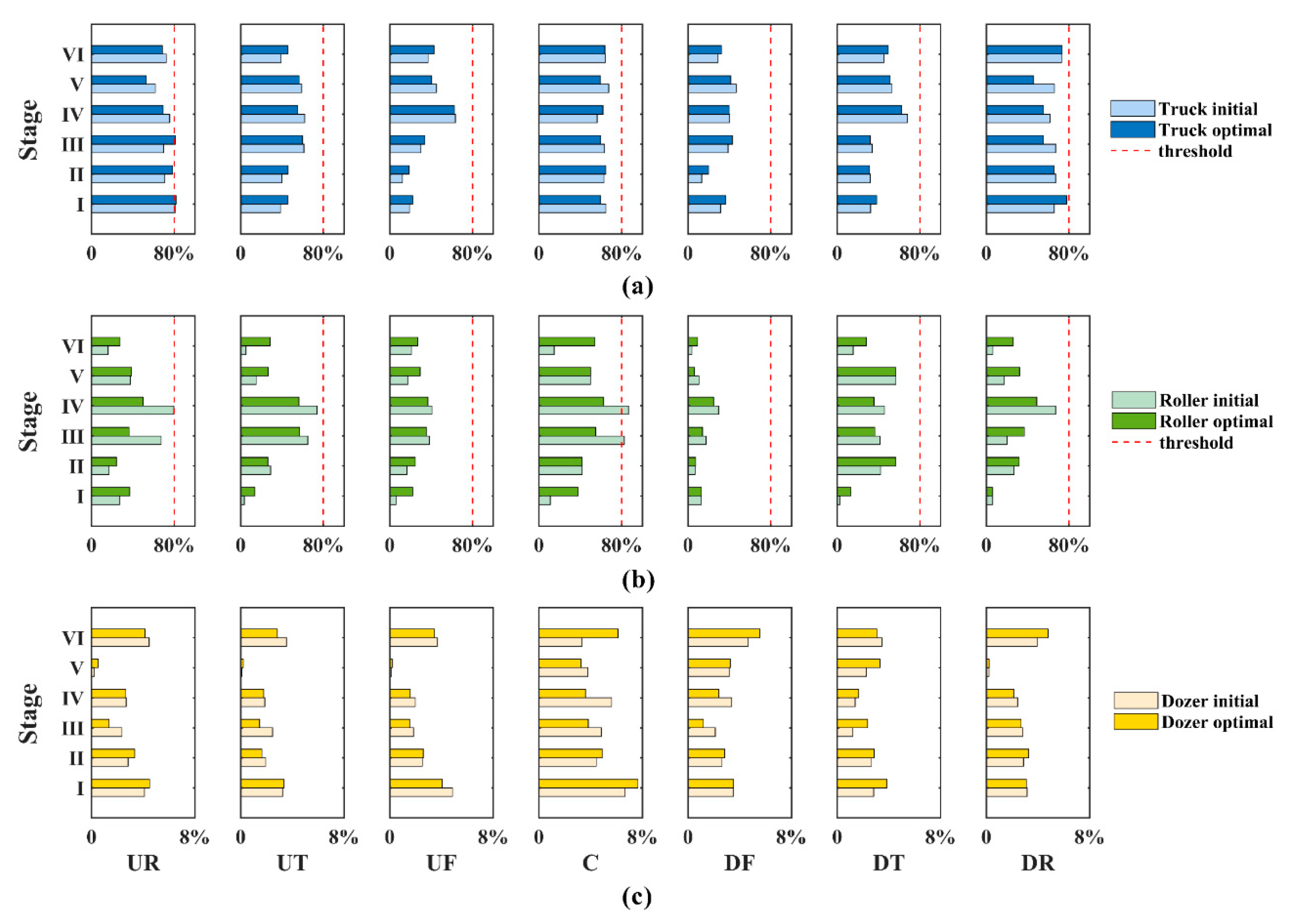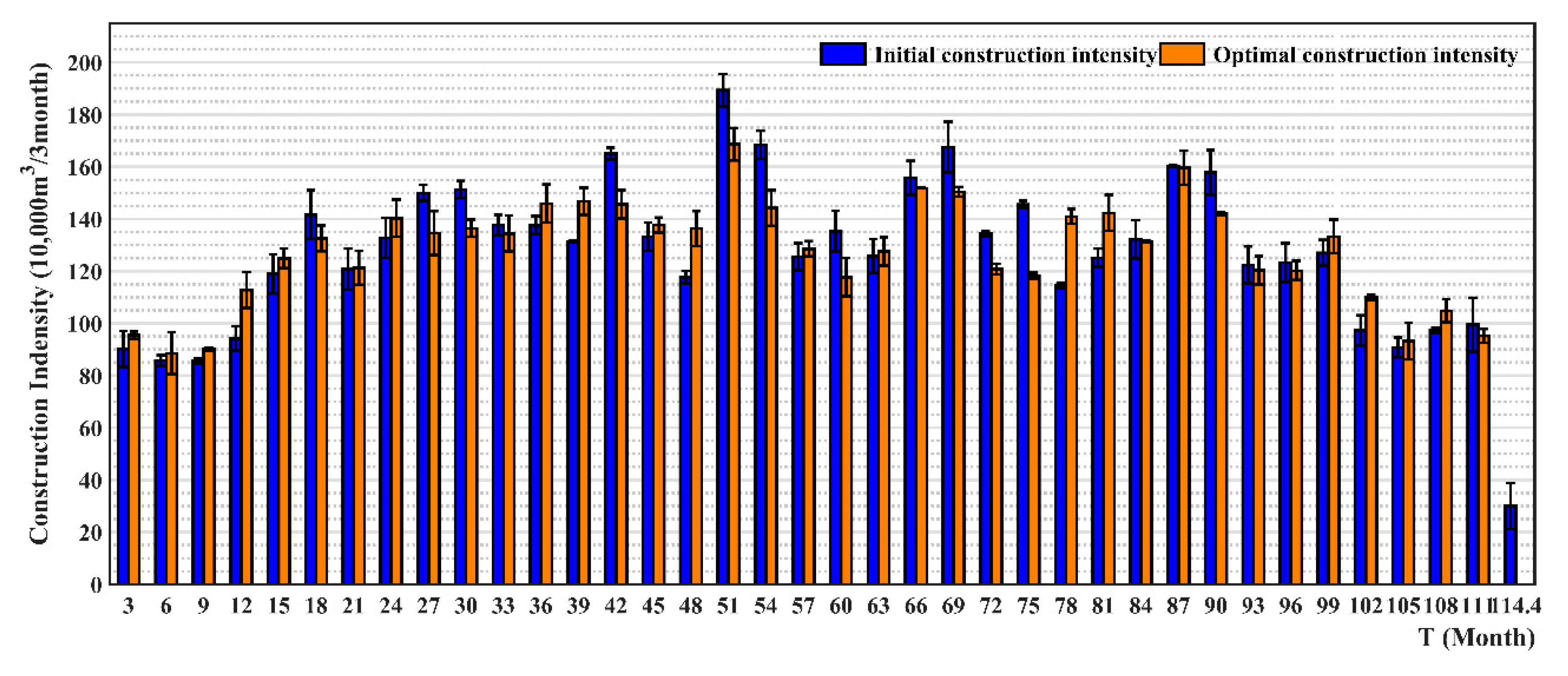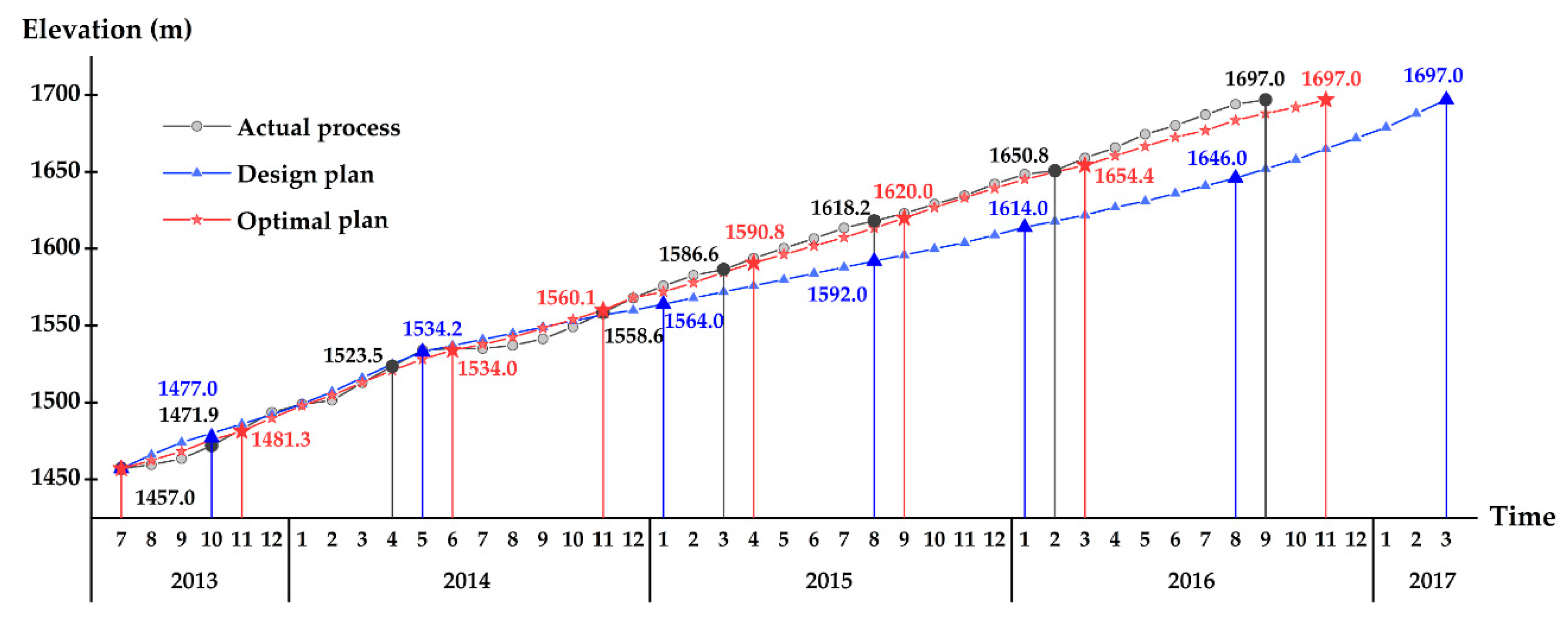1. Introduction
Hydropower is an advantageous option for clean energy. Rockfill dams have become a popular type of hydropower infrastructure because their raw materials are abundant [
1,
2]. In recent years, rockfill dams have grown in size, and their construction time may exceed a decade [
3]. Therefore, the construction process of rockfill dams is divided into several stages to ensure an efficient and successful construction, while the dam body is divided into several zones for different functions. The arrangement of time for each stage and the division of zones by height represent the problem of the rockfill dam construction stage and zone optimization, which is critical in planning the construction process of rockfill dams.
Figure 1 illustrates the work breakdown structure (WBS) of a high core rockfill dam construction as an example. Each zone is constructed in the sequence of filling layers, while each filling layer is constructed by means of flow shop. It is beneficial to determine a flow shop construction scheme derived from every filling layer’s alternative. Traditional design of the construction stages and zones is mainly based on expert experience of similar engineering [
4], lacking scientific basis. To address this problem, a construction stage and zone optimization model was proposed in Reference [
5]. Particle swarm optimization (PSO) and its enhanced variant, heterogeneous particle swarm optimization (HPSO), have been used to solve the optimization model [
6,
7,
8]. However, these researches simplified the filling process of rockfill dam construction, resulting in the difficulty of obtaining the flow shop construction scheme.
Construction simulation of a high rockfill dam is regarded as an ideal tool to help analyze and plan the dam construction process, due to its advantages of considering the elevation difference constraints of each zone and the restrictions of time and space. Zhong [
3] proposed construction simulation of a high rockfill dam (CSHRD) based on CYCLONE. The CSHRD mainly considered the effect of the haulage subsystem and simplified the placement subsystem. Based on the CSHRD, an improved CSHRD that considers the haulage subsystem and placement subsystem by refining flow shop construction is developed and applied [
9,
10]. Du [
9] introduced the improved CSHRD to analyzed flow shop construction and used a genetic algorithm (GA) to optimize the construction stages and zones. Although this research obtained a detailed flow shop scheme while construction stage and zone optimization, a preferable flow shop scheme cannot be selected based on the opinions of decision makers.
On the basis of different decision indicators obtained from rockfill dam construction simulation, preferences of decision makers need to be considered to determine the flow shop construction schemes at different elevations. This is a typical multi-criteria decision-making (MCDM) process. The improved CSHRD is used to compute different flow shop construction scheme evaluation criteria for each filling layer. Then, an MCDM approach is needed to identify the criteria and integrate expert assessments, during which objective data are integrated with subjective judgments. With respect to the construction scheme design, many MCDM approaches have been used, including the weighted sum method, the analytical hierarchical process (AHP), the analytic network process (ANP), ESORD and technique for order performance by similarity to ideal solution (TOPSIS) [
11,
12,
13,
14]. Shapira and Goldenberg [
15] developed an equipment selection model for construction projects based on the AHP. Lashgari et al. [
16] used fuzzy TOPSIS to establish an MCDM model for equipment selection. Zhong et al. [
17] applied TOPSIS and AHP to determine the best compromise construction scheme. Prascevic and Prascevic [
18] improved the fuzzy AHP based on the eigenvalue and eigenvector approach and applied it to rank and select alternatives in construction project management. In these cases, alternative solutions and corresponding decision indicators are countable and limited and can be immediately obtained, allowing the MCDM approach to be applied directly. However, regarding the decision-making process of flow shop construction schemes, the number of filling layers is enormous, and the procedure to obtain decision indicators of solutions is complex. Consequently, both the efficiency of collecting and aggregating the information and the effectiveness of combining the subjective and objective weights to evaluate decision alternatives are challenges that need to be addressed. Accordingly, a data-driven method and the analytical hierarchy process extended by D numbers (D-AHP) [
19] are introduced in this paper. The D-AHP method extends the AHP method with D numbers-based fuzzy preferences [
20], which overcomes the shortcomings of the AHP method that cannot represent and handle the uncertain objective data. D numbers is a new representation of uncertain information developed by Deng [
21], which overcomes the deficiencies of the Dempster–Shafer evidence theory [
22,
23] and contains the exclusiveness hypothesis and completeness constraint. Improving the traditional AHP and Dempster–Shafer theories, the D-AHP method has been proven effective in various areas, including the evaluation of the scientific research ability of universities [
24], curtain grouting efficiency assessment [
25] and construction management [
26]. Therefore, the D-AHP method is used in this paper to integrate hard data with subjective judgments, which may be uncertain and fuzzy in the MCDM process for flow shop construction schemes. Moreover, a data-driven method is introduced to improve the D-AHP. The data-driven method uses simulation results data to generate the D matrix automatically instead of collecting information according to decision makers’ intuition, which will improve the efficiency of the MCDM process.
After determining the optimal flow shop construction scheme, construction filling intensity can be obtained through the improved CSHRD model. Different plans of construction stages and zones will be assigned different values of filling intensity disequilibrium, which is an important indicator reflecting resource balance. The minimum of filling intensity disequilibrium is taken as the objective of construction stage and zone optimization. At present, a number of meta-heuristic algorithms inspired by phenomena in nature have been presented, such as Cuckoo Search (CS) [
27], Genetic algorithm (GA) [
28], Simulated annealing (SA) [
29], Ant colony algorithm (ACA) [
30], Bacteria Foraging Optimization Algorithm (BFOA) [
31] Harmony Search (HS) [
32], Grasshopper Optimization Algorithm (GOA) [
33], Salp Swarm Algorithm (SSA) [
34], Particle Swarm Optimization (PSO) [
35], Ant Lion Optimization (ALO) [
36], Grey Wolf Optimization (GWO) [
37], Enhanced Grey Wolf Optimization (EGWO) [
38], Whale Optimization Algorithm (WOA) [
39] and so on. These meta-heuristic algorithms have played an important role in engineering optimization problems due to their minimal requirements for quantities of input parameters and higher computational efficiency [
40,
41,
42]. Among them, GA [
9,
17,
43,
44,
45], ACA [
46] and PSO [
47] are usually used in construction plan optimization. Besides, a smart BFOA is developed for dam construction [
48]. SA and GA were used to improve the quality of prediction [
49]. SSA was utilized to locate and optimize the size of renewable distributed generators (RDGs) [
50]. HS was applied to training an echo estate neural network [
51]. GWO and its enhanced variants were utilized in various of researches, such as optimizing controllers [
52,
53,
54], solving Combined Heat and Power Dispatch (CHPD) problem [
55] and so on. Motived by the enormous success of meta-heuristic algorithms, a more mature meta-heuristic algorithm with stronger ability to overcome the universal deficiencies existed, such as local optimum points and prematurity, is interesting to be tried in the problem of construction stage and zone optimization. The whale optimization algorithm (WOA), proposed by Mirjalili [
39], has proved to be a competitive metaheuristic algorithm in different applications [
56,
57]. The parameters of the WOA are adaptive during the iterative process, which guarantees a good relationship between the exploration and exploitation of the WOA. However, as noted by [
58,
59,
60], the WOA has one major drawback, namely, premature convergence, which reduces its robustness. Levy flight is a random walking strategy discovered by Benoît Mandelbrot, widely employed in metaheuristic algorithms to prevent a local optimal solution [
61,
62,
63]. The step lengths of Levy flight have a heavy power law tail distribution, and the large steps occasionally help an algorithm to jump out of the local optimum and improve robustness. Therefore, the Levy flight trajectory is used in this paper to improve the WOA, thus, a more robust optimization method for construction stage and zone optimization is obtained.
To summarize, a detailed flow shop construction scheme that considers decision-makers’ opinions has not been obtained in previous rockfill dam construction stage and zone optimization studies. Additionally, a more efficient and robust meta-heuristic algorithm is worth to be developed for construction stage and zone optimization. In view of the problems mentioned above, this research develops a construction stage and zone optimization model that considers the flow shop construction scheme decision. A flow shop construction scheme is determined by balancing different decision criteria, then the optimal construction stage and zone design with a minimum disequilibrium degree of filling intensity is achieved. The main aim of this paper is to:
Establish a new construction stage and zone optimization model to determine detailed flow shop construction scheme that considers decision-makers’ opinions while optimizing construction stages and zones.
Present an automatic flow shop construction scheme optimization method integrated with an improved CSHRD and data-driven D-AHP to determine a preferable flow shop scheme for each filling layer and settle the decision-making efficiency problem caused by the enormous number of filling layers.
Develop a competitive meta-heuristic algorithm, named the enhanced whale optimization algorithm (EWOA), to optimize the construction stage and zone plan efficiently.
The proposed model is applied to a core rockfill dam in southwestern China and the optimal construction stage and zone optimization as well as the construction scheme containing the division of flow shop and the machinery allocation are obtained efficiently. Compared to other optimization methods, the EWOA optimization model performs best in terms of both efficiency and robustness.
2. Research Framework
In this work, a construction stage and zone optimization model based on the data-driven D-AHP and EWOA is proposed, which can determine a preferable flow shop construction scheme for each filling layer while achieving the optimal construction stage and zone design. The research framework is composed of three levels: optimization objective, method, and case study, as shown in
Figure 2.
At the optimization objective level, the objectives are divided into two parts: the objective of the flow shop construction scheme MCDM, which aims at reducing the construction time, decreasing the construction filling intensity and balancing the machinery allocation; and the objective of the construction stage and zone optimization, which aims to reduce the filling intensity disequilibrium degree.
At the method level, the flow shop construction scheme MCDM method is proposed, which integrates the data-driven D-AHP and improved CSHRD; this method automatically generates and collects decision information, effectively combines subjective information with objective preferences in an uncertain environment, and determines a preferable flow shop construction scheme for each filling layer. An EWOA is proposed that uses the Levy flight trajectory to improve the efficiency and robustness of the WOA to optimize the construction stage and zone plan.
At the case study level, the proposed model is applied to a large-scale rockfill dam in southwestern China, and the optimal plan of construction stages and zones as well as the construction scheme that contains the division of the flow shop and machinery allocation is obtained. Compared with the scheme made based on experience, the validity of the model is verified. Compared to other optimization approaches, the EWOA optimization approach demonstrates the best performance in both efficiency and robustness.
5. Validation
The case in Reference [
3] was taken as an example to verify the model proposed. The optimal result was compared with actual process data collected from the real-time monitoring system. The analysis of schedule, machinery utilization rate, and construction disequilibrium degree is discussed as follows.
In terms of schedule, the dam body construction was completed in September 2016. As shown in
Figure 17. The filling elevation of the optimization plan was basically consistent with the actual construction. However, monthly filling elevation was unbalanced in the actual construction process due to the problem of construction organization, especially in the early stage of construction. Total construction period of the optimization plan was 41 months, 4 months shorter than the design plan and 2 months longer than the actual process.
With respect to the machinery utilization rate, the utilization rate of the core wall is taken as a comparison. Because the construction quality control of the core wall, whose role is to prevent seepage, is the most strict, the construction of core is the critical path in dam body construction. Moreover, trucks and rollers are busier than dozers, so our main concern is TUR and RUR. As shown in
Table 5, the TUR and RUR of the optimal plan are not much different from the actual situation and are more balanced among stages.
Regarding the disequilibrium degree, the filling disequilibrium degrees of actual construction, the initial plan and the optimal plan can be obtained with Equation (2), with values of 2.9, 1.8, and 1.21 respectively.
The reasonability of the propose construction stage and zone optimization model based on the data-driven D-AHP and EWOA was able to be validated through comparison between the above three indicators. Consequently, the model proposed could provide guidance for the design and construction of a rockfill dam.
